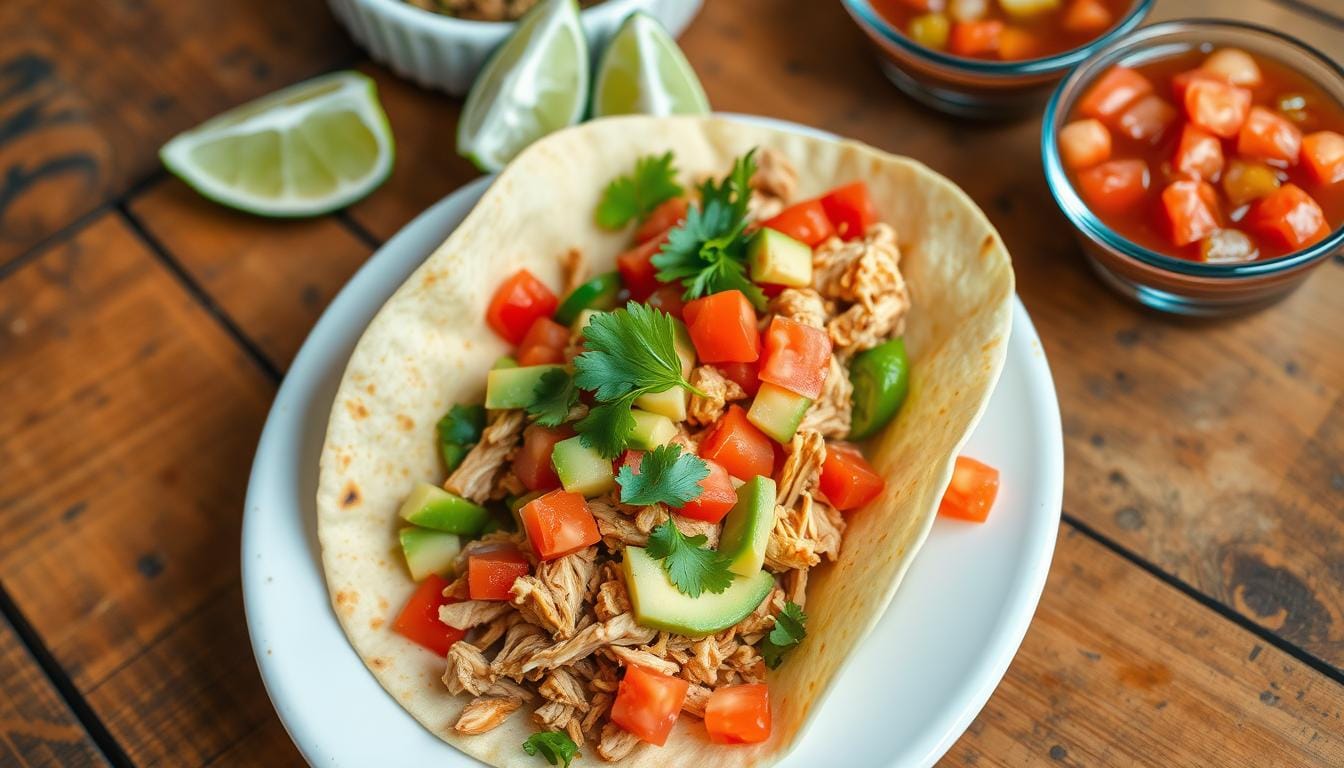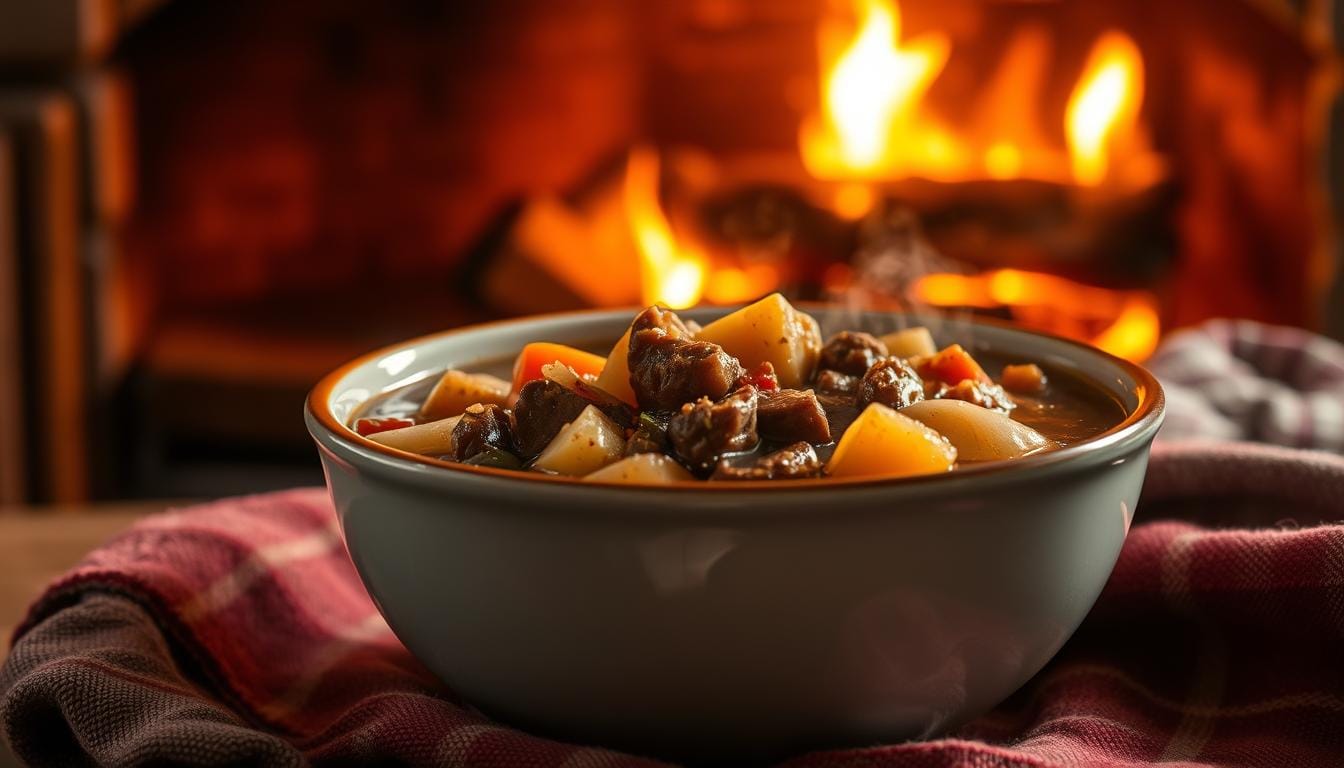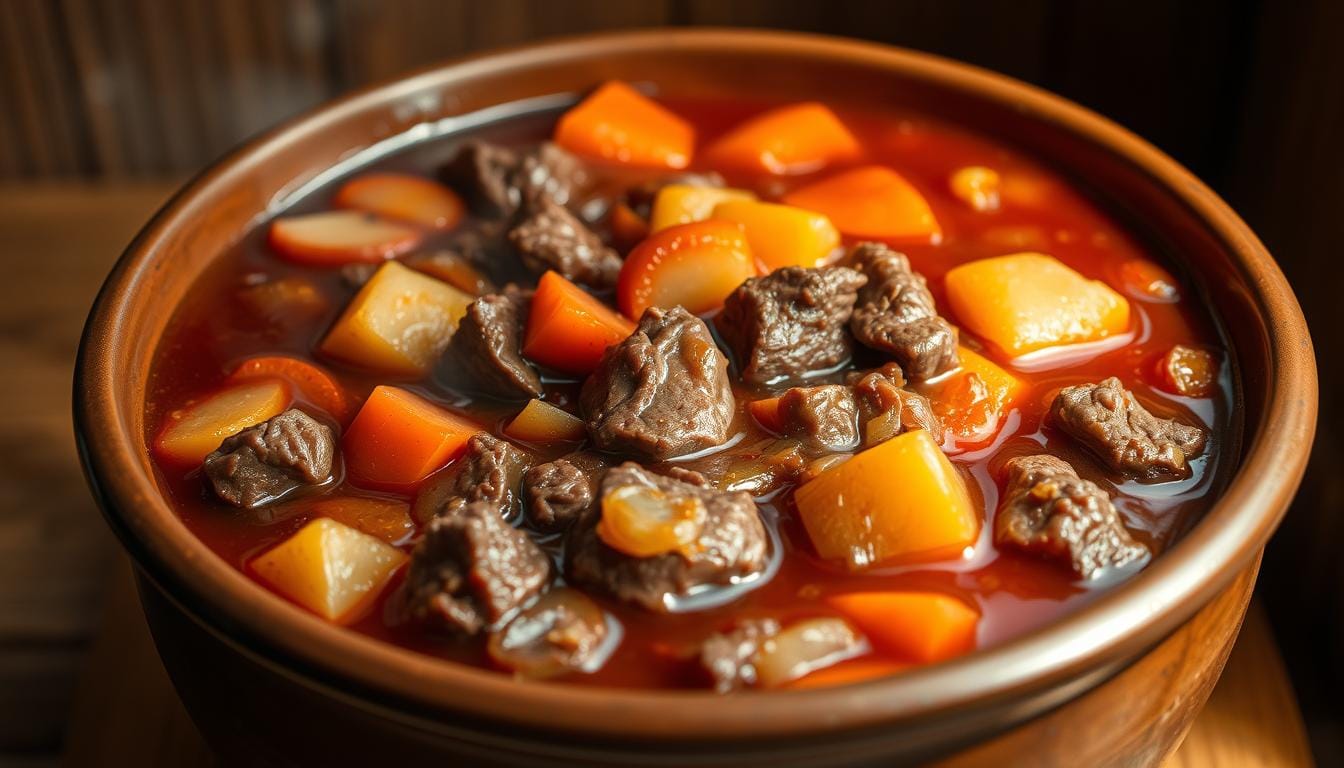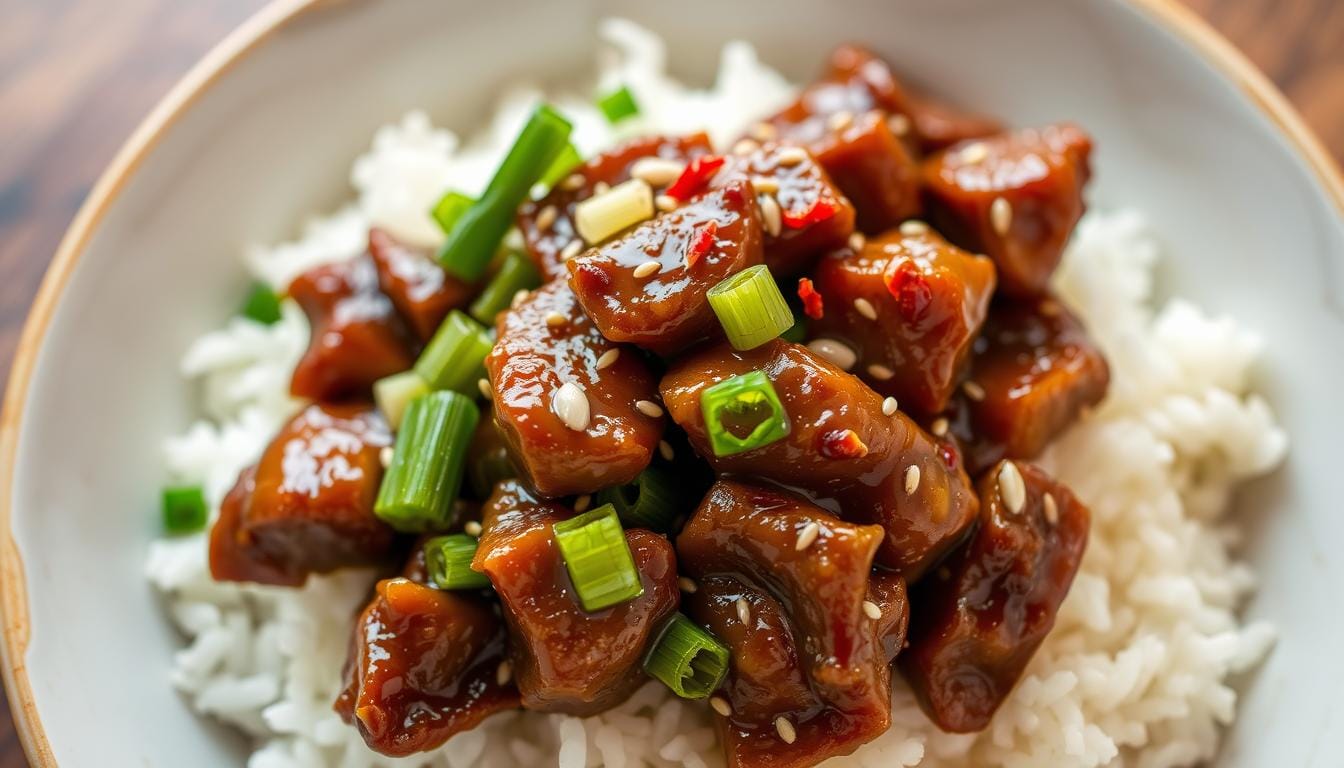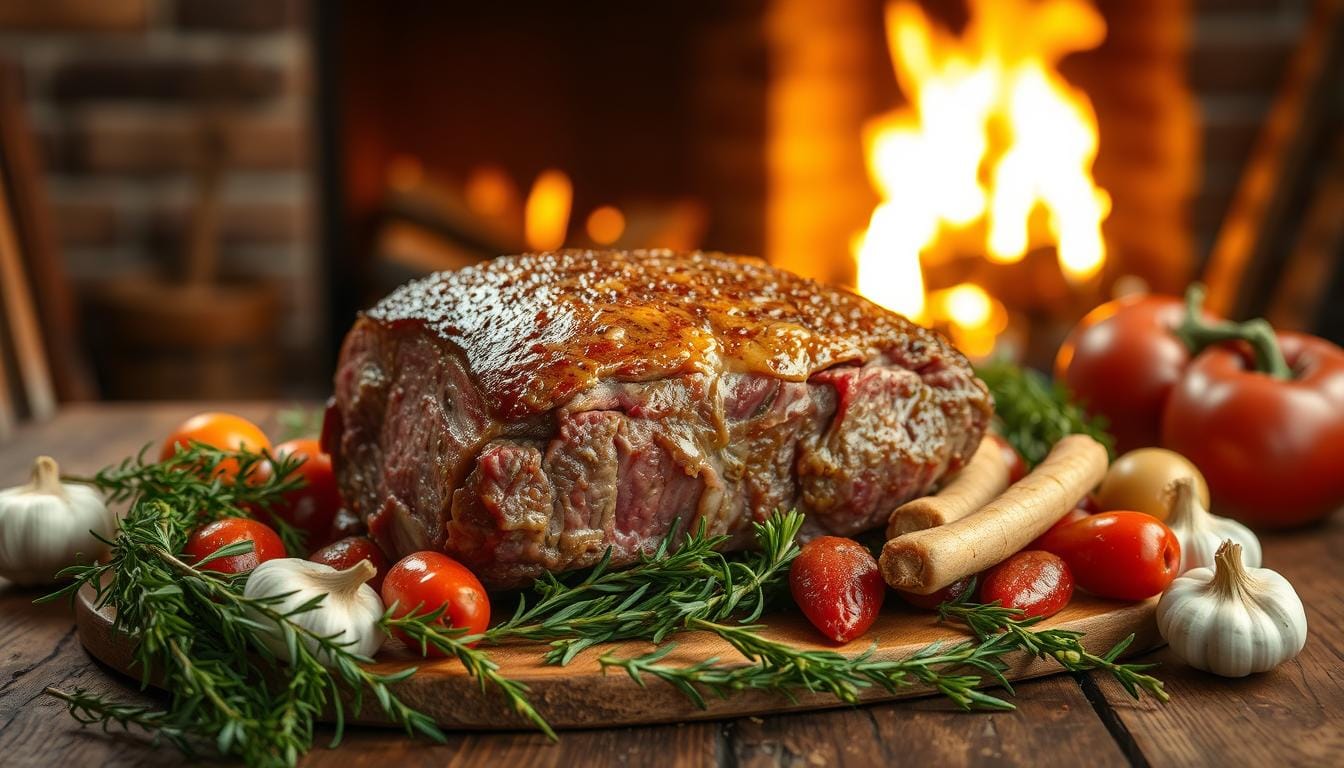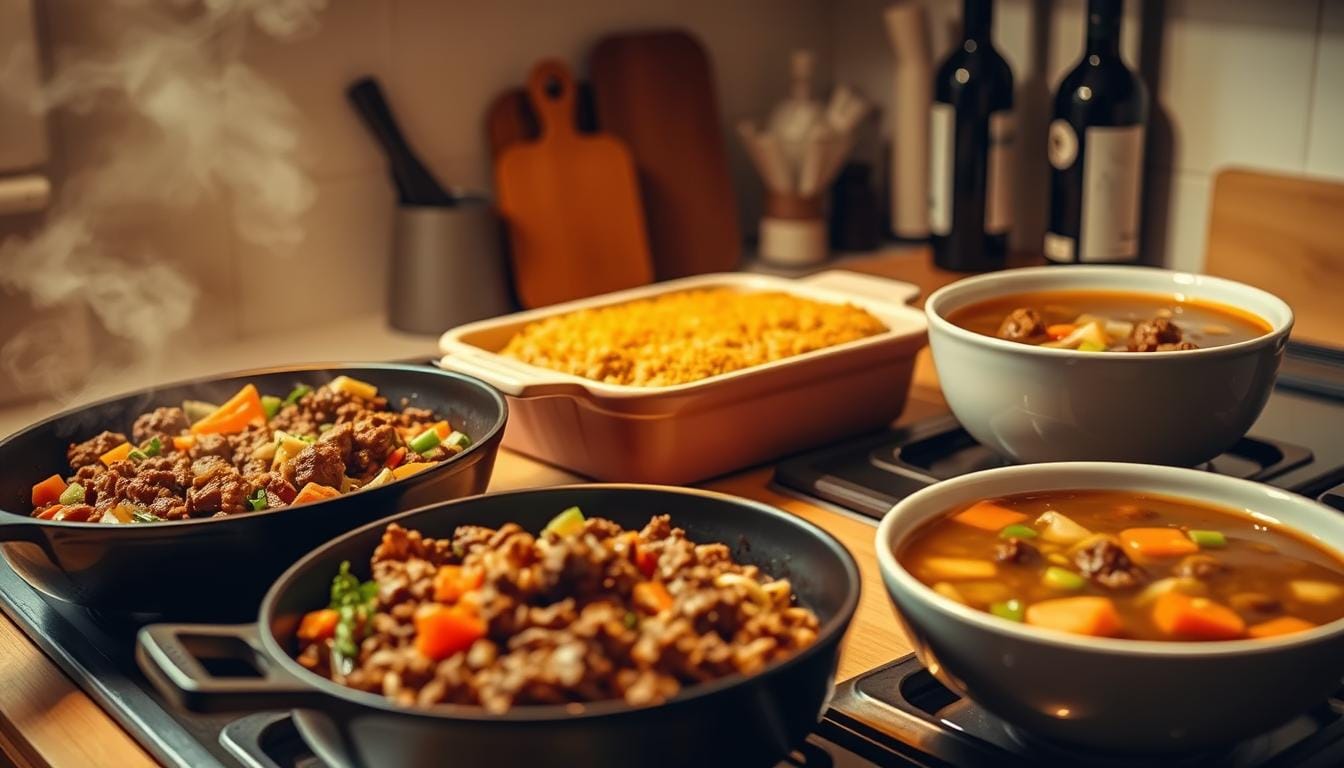Easy Corned Beef and Cabbage Recipe for St. Patrick’s Day
Table of Contents
Corned Beef and Cabbage Recipe
As March comes, my kitchen turns into a place of Irish-American food tradition. The smell of corned beef and cabbage fills the air. It brings back memories of family and St. Patrick’s Day meals. This recipe serves 4-6 people, perfect for family gatherings.
Growing up, I learned this meal is more than food. It’s about sharing stories. Irish immigrants in America made this dish, showing their adaptability and community spirit. This recipe will make your kitchen warm and inviting, filled with history and flavor.
Get ready to make a delicious St. Patrick’s Day meal. We’ll show you how to pick the right beef and cook it perfectly. You’ll learn to make a dish that honors a beloved tradition.
Introduction to Corned Beef and Cabbage
Irish-American cuisine is rich and celebrates cultural heritage through iconic dishes. Corned beef and cabbage is a beloved staple. It bridges traditional Irish cooking and American adaptation.
The story of Irish corned beef is fascinating. It’s rooted in historical necessity and culinary creativity. This dish was not a traditional meal in Ireland. Instead, it emerged as a unique Irish-American cuisine innovation.
What is Corned Beef and Cabbage?
Corned beef and cabbage is a hearty dish. It features:
- Salt-cured beef brisket
- Tender boiled cabbage
- Accompanying root vegetables
“Corned beef got its name from the corn-kernel-sized salt crystals used in curing the meat during the 17th century.”
Origin and History of the Dish
The British first coined the term “corned beef” in the 17th century. Irish immigrants in New York City adapted their traditional bacon and cabbage recipe. They replaced expensive bacon with more affordable beef due to economic constraints.
| Cultural Element | Details |
|---|---|
| Origin Country | United States (Irish-American adaptation) |
| Primary Ingredients | Beef brisket, cabbage, root vegetables |
| Typical Preparation | Boiling or slow cooking |
This culinary transformation is more than just a recipe. It symbolizes the resilience and adaptability of Irish immigrants. They created a new cultural identity through food.
Ingredients Needed for the Recipe
To make a tasty corned beef and cabbage dish, you need to pick the right ingredients. Start by gathering the essential parts for a meal that’s both authentic and full of flavor.
Essential Ingredients for Your Corned Beef Brisket
For the best corned beef brisket, you’ll need these key items:
- 3-4 pound corned beef brisket with spice packet
- 1 large head of green cabbage
- 6 Yukon Gold potatoes
- 12 slender carrots
- Beef broth
Spice Blend and Flavor Enhancers
The secret to great corned beef is its spice blend. Mix these seasonings for a bold flavor:
| Spice | Quantity |
|---|---|
| Mustard seed | 1/4 teaspoon |
| Coriander seed | 1/4 teaspoon |
| Whole cloves | 1/8 teaspoon |
| Whole peppercorns | 1/8 teaspoon |
| Bay leaves | 2-3 leaves |
Optional Ingredients for Cabbage Side Dish Variations
Make your corned beef and cabbage even better with these optional items:
- Herbs: Fresh thyme or rosemary
- Vegetables: Parsnips or turnips
- Liquid: Use beer instead of water for more flavor
- Garnish: Fresh parsley or chives
“The right ingredients transform a simple meal into a memorable feast.”
Choosing top-notch ingredients is key to a delicious corned beef and cabbage dish. Your family and friends will be amazed.
Preparation Steps Before Cooking
Before you start cooking the perfect corned beef, you need to prepare well. The success of your boiled corned beef depends on the right ingredients and careful preparation.
Selecting the Right Cut of Corned Beef
When picking your corned beef, aim for a high-quality brisket. It should weigh between 3 to 4 pounds. Look for a cut that has a mix of lean meat and fat. This mix ensures the meat is both flavorful and tender.
- Choose a brisket with even marbling
- Check for a bright red color
- Select meat with a firm texture
- Inspect the packaging for freshness
Preparing Your Corned Beef
Getting your corned beef ready is key to a tasty dish. Take the corned beef out of its packaging and rinse it with cold water. This helps cut down on the saltiness.
“The key to a great boiled corned beef is in the preparation.” – Irish Cooking Experts
Prepping Cabbage and Vegetables
Don’t forget to prepare your vegetables well. Cut the cabbage into 8 wedges. Also, get ready other vegetables for a full meal.
| Vegetable | Quantity | Preparation |
|---|---|---|
| Baby Red Potatoes | 1½ pounds | Wash and quarter |
| Carrots | 4 large | Peel and chop into chunks |
| Yellow Onion | 1 whole | Peel and slice |
| Cabbage | 1 small head | Cut into 8 wedges |
Pro tip: Prepare all vegetables before starting to cook to ensure a smooth cooking process for your corned beef recipe.
Cooking Methods for Corned Beef and Cabbage
Choosing the right cooking method is key for a tasty St. Paddy’s Day dinner. Whether you’re new to cooking or experienced, different methods can make your meal a hit with your guests.
Traditional Stovetop Cooking
Stovetop cooking is a classic way to make corned beef. It lets you control the temperature and brings out the flavors. Here’s how to do it:
- Place corned beef in a large pot
- Cover with water or broth
- Bring to a gentle simmer
- Cook for approximately 3-4 hours
Slow Cooker Magic
Slow cooker corned beef is easy and perfect for St. Paddy’s Day. It cooks the meat low and slow, making it tender.
- Place corned beef in the slow cooker
- Add spices and liquid
- Cook on LOW for 8-10 hours
- Add vegetables during the last hour
Pro tip: For maximum flavor, choose a flat-cut brisket weighing 3-4 pounds.
Instant Pot Efficiency
If you’re short on time, the Instant Pot can cook corned beef in under 90 minutes. It’s great for those who want a quick, delicious meal.
- Use HIGH pressure setting
- Cook for approximately 80 minutes
- Allow natural pressure release
- Rest meat before slicing
Each cooking method has its own benefits. The most important thing is to cook at a low, steady heat. This will make your corned beef tender and full of flavor for your St. Paddy’s Day feast.
Cooking Time and Temperature
Mastering the art of cooking corned beef and cabbage is all about timing and temperature. Your recipe needs careful attention for a tender, flavorful dish that will wow your guests.
Cooking Duration and Temperature Essentials
- Preheat the oven to 325 degrees Fahrenheit
- For every pound of beef, allow approximately one hour for cooking.
- 3- to 4-pound brisket takes 3.5 to 4 hours to cook.
- Optimal internal temperature: 180-190 degrees Fahrenheit
Achieving Fork-Tender Perfection
The secret to a great corned beef and cabbage recipe is patience and careful temperature monitoring. Slow and steady wins the race in turning tough meat into a tender delight.
“Cooking corned beef is an art of patience and precision” – Culinary Experts
Checking Doneness and Tenderness
- Check the interior temperature with a meat thermometer.
- Make sure the temperature is at least 145 degrees Fahrenheit.
- Use a fork to pierce to check for tenderness.
- Meat should feel soft and offer little resistance when fully cooked
Pro tip: If your corned beef isn’t fork-tender after the recommended time, cook for another 30-45 minutes. Aim for a texture that’s almost falling apart when touched.
Flavor Enhancements and Seasoning
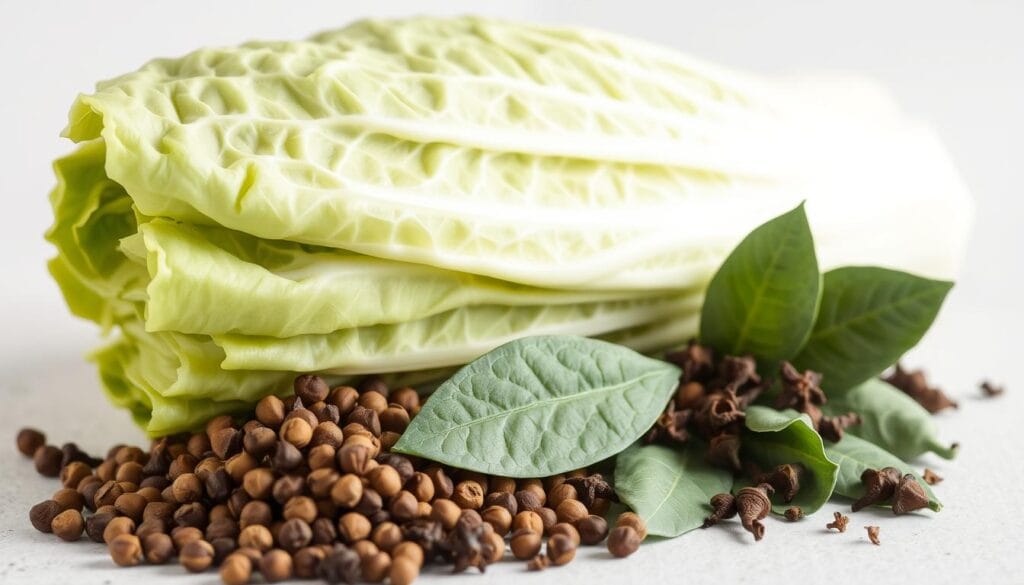
Making the perfect Irish corned beef recipe is more than just cooking. The right seasonings can turn your dish into something amazing. They bring out rich flavors that make your taste buds dance.
Traditional Seasonings That Make a Difference
The spice packet is your secret ingredient when cooking corned beef. It has a mix of seasonings that make the meat taste better.
- Mustard seeds for a subtle tangy kick
- Coarse ground black pepper (½ tsp)
- Brown sugar (¼ cup) for caramelization
- Bay leaves for earthy undertones
- Whole black peppercorns
Elevating Your Irish Corned Beef with Herbs and Spices
To make your traditional recipe even better, try these extra flavors:
| Herb/Spice | Flavor Profile | Recommended Quantity |
|---|---|---|
| Garlic | Robust and pungent | 5-6 cloves, chopped |
| Fresh Thyme | Earthy and aromatic | 2-3 sprigs |
| Rosemary | Pine-like and intense | 1-2 sprigs |
Pro tip: Try different herb mixes to find your special flavor!
“Seasoning is the soul of any great dish” – Culinary Wisdom
The secret to a great corned beef recipe is mixing traditional flavors with your own twist. Don’t be shy to try new seasonings!
Serving Suggestions for Your Dish
Creating the perfect corned beef and cabbage experience is more than just the main dish. Your St. Patrick’s Day meal needs sides and drinks that make it special.
Delectable Side Dishes to Complement Corned Beef
Here are some tasty cabbage side dishes for your corned beef and cabbage:
- Crusty Irish soda bread
- Roasted root vegetables
- Creamy mashed potatoes
- Colcannon (traditional Irish potato dish)
Perfect Beverage Pairings
Make your St. Patrick’s Day meal even better with these drinks:
| Alcoholic Options | Non-Alcoholic Choices |
|---|---|
| Guinness Stout | Irish Breakfast Tea |
| Irish Whiskey | Sparkling Apple Cider |
| Irish Red Ale | Mineral Water |
Sauce and Condiment Recommendations
Try these tasty sauces and condiments with your corned beef:
- Creamy horseradish sauce
- Whole grain mustard
- Sour cream
“The right side dishes and beverages can transform a good meal into an unforgettable dining experience.”
For a memorable St. Patrick’s Day meal, balance flavors and create a festive atmosphere. This celebrates Irish culinary traditions.
Storing Leftovers
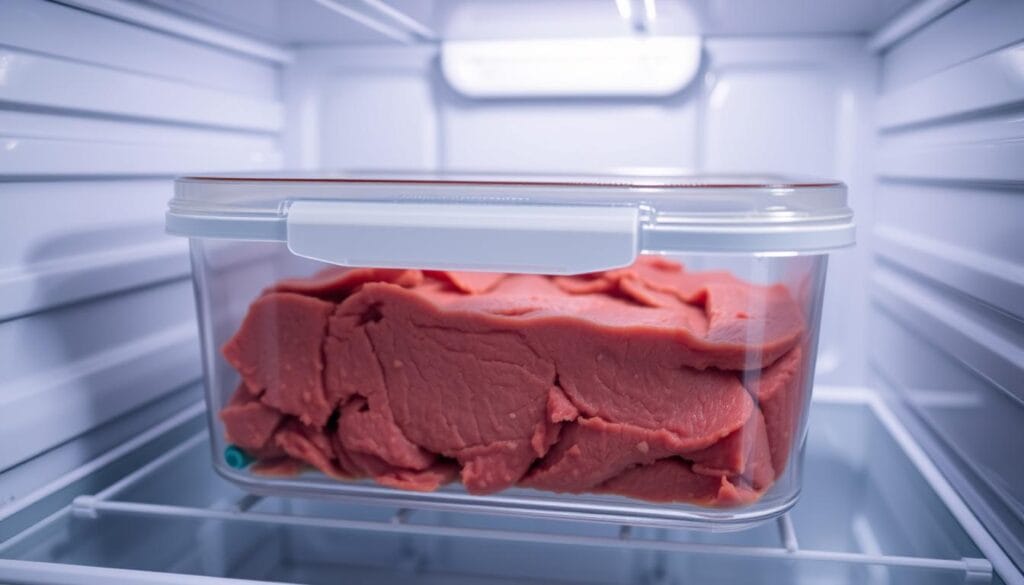
After enjoying your delicious Irish-American cuisine, knowing how to store and repurpose your corned beef and cabbage leftovers can transform your meal into multiple delightful dishes. Proper storage ensures you can enjoy your culinary creation for days to come.
Proper Storage Techniques
Storing your corned beef and cabbage requires careful attention to food safety and flavor preservation. Follow these essential guidelines:
- Refrigerate leftovers within two hours of cooking
- Store in airtight containers to maintain freshness
- Keep corned beef refrigerated for up to 5 days
- Leftover corned beef and cabbage soup can be stored for 3-4 days
Reheating Tips for Best Flavor
Reheating your corned beef requires gentle techniques to preserve its tenderness and taste. Here are some expert recommendations:
- Use low to medium heat when reheating
- Add a splash of broth to prevent drying out
- Cover the meat while warming to retain moisture
- Avoid microwave reheating when possible
“Leftover corned beef is a gift that keeps on giving – transform it into sandwiches, soups, or hash for continued culinary enjoyment!”
Creative leftover ideas include making reuben sandwiches, chopping the meat into a hearty soup, or creating corned beef hash. The versatility of this Irish-American classic means you can enjoy multiple meals from a single cooking session.
Pro tip: Freeze your leftover corned beef and cabbage soup in sealed containers for up to 3 months. When ready to enjoy, thaw overnight in the refrigerator and warm gently on the stove.
Nutritional Information
Irish corned beef is a meal full of essential nutrients. It’s rich and complex. Knowing its health benefits helps you make better food choices.
Health Benefits of Corned Beef
Corned beef brisket is great for those looking for a protein-rich meal. It’s packed with vitamins and minerals:
- High protein content supporting muscle development
- Significant source of Vitamin B12
- Rich in essential minerals like iron and zinc
- Provides substantial energy through balanced macronutrients
Comprehensive Nutritional Breakdown
A typical serving of corned beef and cabbage has a great nutritional profile:
| Nutrient | Amount | % Daily Value |
|---|---|---|
| Calories | 327 | 16% |
| Protein | 18g | 36% |
| Fat | 19g | 29% |
| Carbohydrates | 24g | 8% |
| Vitamin B12 | 5μg | 200% |
| Iron | 8mg | 106% |
Note: Nutritional values are based on a typical 4 oz serving of corned beef brisket with vegetables.
“Enjoying corned beef in moderation can be part of a balanced diet while providing essential nutrients.” – Nutritional Experts
While tasty, corned beef has a lot of sodium and saturated fats. Eating it with veggies like cabbage makes the meal better. Remember to watch your portion sizes and dietary needs when you eat this Irish classic.
Variations on the Classic Recipe
Looking to spice up your St. Paddy’s Day dinner? Try new twists on the classic corned beef and cabbage recipe. Adding different ingredients and cooking methods can make this dish truly special. It keeps the essence of the original while adding your personal touch.
Unexpected Vegetable Alternatives
While cabbage is traditional, why not try these other veggies in your corned beef and cabbage recipe?
- Roasted Brussels sprouts
- Crispy roasted parsnips
- Rainbow Swiss chard
- Honey-glazed rainbow carrots
- Butternut squash cubes
Creative Cooking Liquid Alternatives
Make your St. Paddy’s Day dinner even better by using these flavorful liquids instead of water or beef broth:
- Guinness Beer: Gives your corned beef a rich, malty flavor
- Apple cider for a hint of sweetness
- Red wine for added complexity
- Vegetable stock for a lighter taste
“Cooking is an art, and corned beef is your canvas!” – Chef’s Secret
Unexpected Spice and Seasoning Twists
Give your corned beef and cabbage recipe a boost with these unique seasonings:
- Smoked paprika for a smoky taste
- Fresh rosemary and thyme
- Whole grain mustard glaze
- Maple syrup and bourbon reduction
Cooking is all about being creative. Don’t hesitate to try new things and make this dish your own!
Conclusion: Enjoying Your Corned Beef and Cabbage
Your St. Patrick’s Day meal is now complete with this classic Irish-American cuisine recipe. Preparing corned beef and cabbage is more than cooking. It’s about connecting with a rich culinary tradition that has delighted generations of food lovers across the United States.
Remember, perfecting this dish takes practice. Each time you prepare corned beef and cabbage, you’ll find new ways to improve flavor and tenderness. Whether you use the Instant Pot or traditional stovetop cooking, the key is patience and attention to detail.
To expand your Irish-inspired culinary repertoire, consider exploring other traditional dishes like Irish Apple Cake, Dublin Coddle, or Irish Soda Bread. These recipes will help you dive deeper into the rich flavors of Irish-American cooking and create memorable meals that celebrate cultural heritage.
Ultimately, cooking is about sharing joy with friends and family. Your homemade corned beef and cabbage will not just be a meal, but a celebration of tradition, flavor, and the warm spirit of St. Patrick’s Day.
FAQ
Is corned beef and cabbage really an Irish dish?
Corned beef and cabbage is not a true Irish dish. In Ireland, people ate bacon or lamb. Irish immigrants in the U.S. chose corned beef for its affordability and availability.
What cut of beef is best for corned beef?
Beef brisket is the top choice for corned beef. Look for a brisket with marbling for tenderness and flavor. The flat cut is leaner, while the point cut is fattier and tenderer.
How long does it take to cook corned beef and cabbage?
Cooking time depends on the method and meat weight. Stovetop cooking takes about 50 minutes per pound. Slow cookers need 4-5 hours on low. An Instant Pot takes about 90 minutes, including prep and natural pressure release.
Can I make corned beef and cabbage ahead of time?
Yes, you can! Corned beef tastes better when made ahead. Prepare it 1-2 days before and reheat gently in the cooking liquid. This enhances flavors and tenderness.
Is corned beef a healthy meal?
Corned beef is high in protein but also in sodium and saturated fat. A serving has 210-250 calories and lots of protein. Cabbage adds vitamins and fiber. Trim fat and control portions for a healthier meal.
Can I make this recipe in a slow cooker?
Yes! Slow cookers are great for corned beef and cabbage. The low heat tenderizes the meat and infuses flavor. Place the corned beef in the slow cooker with water or broth and cook on low for 8-10 hours.
What spices are typically used in corned beef?
Traditional spices include peppercorns, bay leaves, mustard seeds, coriander seeds, cloves, and allspice. You can also use a store-bought spice packet or create your own blend.
Are there vegetarian alternatives to this dish?
While there’s no perfect meat substitute, vegetarians can use seitan, tempeh, or jackfruit with corned beef seasonings. Keep the cabbage and vegetables the same for a similar St. Patrick’s Day meal.


